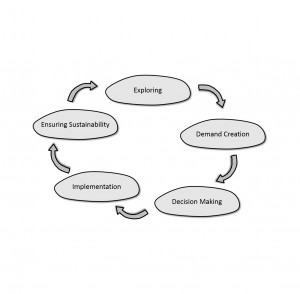Careful planning is crucial for achieving holistic and sustainable Water, Sanitation and Hygiene (WASH) interventions that efficiently meet immediate needs without compromising long-term sustainability. In camp settings (see invalid link factsheet), however, humanitarian actors must work under tremendous time pressure and their capacity for detailed planning is often low. Emergency Preparedness and Contingency Planning play a crucial role for freeing up important resources necessary to carry out WASH Needs Assessments and more detailed Programme and Project Designing.
What makes planning in the camp setting even more complex are the somewhat contradicting expectations towards the life cycle of the interventions: while camps are considered temporary solutions to emergency situations, experience shows that many camps continue to exist beyond the acute emergency phase (see invalid link factsheet). As postulated by the Linking Relief, Rehabilitation and Development (LRRD) concept, it is imperative that humanitarian aid, rehabilitation and reconstruction as well as long-term sustainability are equally considered when planning fast-to-implement interventions for camp settings.
The Sphere Project Core Standards describe the essential processes for achieving the The Sphere Project Standards for humanitarian response. According to the Core Standards, a humanitarian response must ensure 1) a people-centered, rights-based approach that takes into account people’s capacity in designing an appropriate response and 2) coordination and collaboration between all organisations and authorities to ensure maximum efficiency, coverage and effectiveness.
Although interventions in camp settings must be implemented rapidly, the specific needs relating to the context, target group, existing capacities and stage of the crisis must be taken into consideration. An initial WASH Needs Assessment is fundamental for designing an intervention plan (see core standard 3 in the SPHERE Handbook for assessment). The information gathered in the assessment is key for the definition of the objectives and the planned activities of the intervention.
In order to ensure that the planned humanitarian response continues to meet the needs, interventions must be regularly adapted based on the outcomes of a continuous monitoring and evaluation as well as the impact on the affected populations (as stated in Sphere Core Standard 5).
This module presents a number of participatory strategies, approaches and tools for effective and needs-based planning in camp settings.
Emergency Sanitation: Assessment and Programme Design
This book has been written to help all those involved in planning and implementing emergency sanitation programmes. The main focus is a systematic and structured approach to assessment and programme design. There is a strong emphasis on socio-cultural issues and community participation throughout.Includes an extensive “guidelines” section with rapid assessment instructions and details on programme design, planning and implementation.
HARVEY, P. BAGHRI, S. REED, B. (2002): Emergency Sanitation: Assessment and Programme Design. Loughborough: Water, Engineering and Development Centre (WEDC) URL [Accessed: 31.05.2019]The Sphere Handbook
This appendix of SPHERE handbook is a water supply and sanitation initial needs assessment checklist. This list of questions is primarily for use to assess needs, identify indigenous resources and describe local conditions. It does not include questions to determine external resources needed in addition to those immediately and locally available.
THE SPHERE PROJECT (2011): The Sphere Handbook. Rugby: Practical Action Publishing URL [Accessed: 19.10.2016]Concept on LRRD Linking Relief, Rehabilitation and Development
This document establishes the frame of reference for the systematic incorporation of the LRRD approach into the Swiss Red Cross (SRC)’s humanitarian aid operations, its re-construction/rehabilitation activities and its development cooperation programmes, and supplements their specific strategic- conceptual foundations. The concept is the outcome of broadly supported SRC internal processes and provides SRC international cooperation staff with guidelines for planning and implementing the LRRD approach in programmes. It also serves as a basis for dialogue within the International Red Cross and Red Crescent Movement and with partner organisations, authorities and other interested institutions.
SWISS RED CROSS (2010): Concept on LRRD Linking Relief, Rehabilitation and Development. Bern: Swiss Red Cross URL [Accessed: 06.02.2017]

